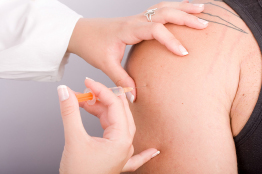Session 2
1. Session 2
1.4. Inquiry 2
Session 2: Health, Safety, and Well-Being of Children
Inquiry 2: Health and Safety Practices in Child Care Centres

© Fernando Delvalle/shutterstock
Sound health and safety practices are critical in child care centres. The Child Care Licensing Regulation addresses some of these practices. In addition, child care centres must follow requirements established by the Alberta Fire Code and the Public Health Act. Health and fire inspectors visit centres to ensure their respective requirements are met.
Children in group care settings are prone to being exposed to various diseases and illness. However, the spread of infectious disease can be kept to a minimum. To do this, caregivers must follow sound health practices. Many of these practices are addressed in the resources for this session.
Everyone benefits from a healthy environment.
- Healthy kids are happy kids!
- Family members have to find alternative care less often.
- Family members are healthier.
- Caregivers are healthy and miss less work, meaning more consistency for the children.
Understanding about infectious (communicable) diseases will help you prevent their spread.
Immunization

© David Davis/shutterstock
When you get sick, your body makes antibodies to fight the disease and help you get better. These antibodies stay in your body, even after the disease has gone, and protect you from getting the same illness again. This is called immunity.
Babies are immune to many diseases because they have antibodies from their mothers. Unfortunately, this immunity does not last and wears off during the first year of life. Fortunately, there is something people can do to keep their children immune. The children can be vaccinated.
Vaccines trick your body so that it thinks it is being attacked by a disease. Your body’s response is to produce antibodies that remain in your body. If a child is exposed to the actual disease, she or he will be protected.
Other names for immunization are
- needles
- baby shots
- vaccines
- vaccinations
A vaccine is a weak or “dead” version of the viruses or bacteria that cause disease. Some of these vaccines can be given to children as needles and others as drops to be swallowed.
When children are immunized, they are protected from
- blood infections
- ear infections
- diphtheria
- influenza
- haemophilus influenzae type b
- hepatitis A and B
- measles (red measles)
- meningitis
- mumps
- tetanus (lockjaw)
- pertussis (whooping cough)
- pneumonia
- polio
- rubella
- varicella (chicken pox)
When children don’t have their shots and come in contact with someone who has measles, whooping cough, or other childhood diseases, they will probably get sick. In some cases, they may become gravely ill. When children are immunized, their bodies have the best chance to fight off these diseases and recover from the illness.
Immunization for Child Care Workers

© Istvan Csak/shutterstock
Vaccinations are not just for children.
Childhood vaccinations do not provide lifelong immunity against some diseases, such as tetanus (lockjaw) and diphtheria. Helper, or booster, shots are required to maintain immunity. As well, adults who were not adequately immunized as children may be at risk of infection from other vaccine-preventable diseases. These adults could, therefore, infect unprotected children if they contract a vaccine-preventable disease. Consult your local public health nurse to make sure you are protected.
Annual influenza immunization is strongly encouraged for anyone who provides regular child care to children less than 24 months of age—whether in or out of the home—to help prevent the spread of influenza. This is because children less than 24 months of age are at an increased risk of hospitalization related to influenza compared to older children and young adults. Alberta Health Services provides free influenza immunization for these adults, as well as for children aged six to 23 months. Influenza vaccines currently available are not very effective in children less than six months of age. Older children with high-risk conditions may also qualify for free influenza vaccines.
For more information on influenza vaccines, see the Alberta Health Services website.
For more information on adult immunization, see the website of the Canadian Coalition for Immunization Awareness and Promotion (CCIAP).
Alberta Routine Immunization Schedule
This is the Alberta routine immunization schedule as it appears on the Alberta Health Services website (April 2010). The schedule is updated as new recommendations for immunizations are introduced. Updates are provided to the website on a regular basis.
|
Age |
Vaccine |
|
2 months |
|
|
4 months |
|
|
6 months |
|
|
6 to 59 months |
|
|
12 months |
|
|
18 months |
|
|
4 to 6 years |
|
|
Grade 5 |
|
|
14 to 16 years |
|
Note: Each bullet represents one vaccine/injection unless otherwise noted.
1 Diphtheria, tetanus, acellular pertussis, polio, haemophilus influenza type b
2 Annually, during influenza season
3 Measles, mumps, rubella
4 Diphtheria, tetanus, acellular pertussis, polio
5 Human papillomavirus
6 Diphtheria, tetanus, acellular pertussis
© 1995–2009 Government of Alberta <http://www.health.alberta.ca/health-info/imm-routine-schedule.html>;
Common Side Effects of Immunization
Risks and side effects from vaccines are much lower than the risk of having the diseases they prevent.
The most common side effects are mild and resolve quickly. Depending on the type of vaccine, some children may experience the following side effects for a day or two:
- redness, swelling, and soreness in the area where the needle was given
- a small, painless lump where the needle was given
- a mild fever, headache, decreased energy, and muscle aches
- fussiness or irritability
If a child experiences mild side effects, do the following:
- For pain or swelling where a needle was given, apply a cool, moist towel to the area.
- If the child has pain or fever, use acetaminophen as directed on the bottle.
For the vaccine for measles/mumps/rubella (MMR), fever with or without a rash can occur one or two weeks after receiving the vaccine. The rash does not spread the disease to others.
There can also be a rash with or without fever one or two weeks after receiving a chicken pox vaccine. Children who develop a chicken pox-like rash following a chicken pox vaccination should keep the rash covered. If this is not possible, the daycare should try to minimize close contact with susceptible high-risk individuals (such as immune-compromised individuals and non-immune pregnant women) for the duration of the rash. Because vaccine virus is rarely transmitted to others in these circumstances, an exclusion from daycare is not necessary.
More severe reactions can occasionally occur. Call the local public health unit or a doctor if you have questions, or if a child has an unusual reaction to a vaccine.
Severe allergic reactions (e.g., anaphylaxis), while unlikely, are possible.
For more details on specific vaccines, contact the local public health office for pamphlets or fact sheets or visit the Alberta Health and Wellness public website.
Applicable Legislation
The Public Health Act
- This act mandates the requirements related to the control of communicable diseases.
- Section 22 states that a person in charge of an institution is required to notify the regional Medical Officer of Health if there is a reason to believe that a person under the institution’s care is infected with a communicable disease.
communicable disease: an infectious disease that can be transmitted from one individual to another either directly or indirectly
The Communicable Diseases Regulation
This regulation outlines the communicable diseases that must be reported to the regional Medical Officer of Health so steps can be taken by public health staff to protect the rest of the population from illness.
The Institutions Regulation
This regulation outlines specific requirements for daycare facilities, in addition to general requirements for every child care facility. These requirements include the following:
- construction
- ventilation and lighting
- plumbing facilities
- waste disposal
- accommodations for sleeping or resting
- maintenance
- first-aid supplies
- food facilities
The Food Regulation
This regulation outlines the requirements for a food establishment to help ensure food is prepared safely. The regulation outlines requirements for the following:
- general construction
- equipment, utensils, and food surfaces that can be used
- operating requirements
- storage requirements
- pest control
- transportation and storage of food
- sanitation procedure requirements for food handlers in terms of hygiene and health
- food safety training
Important: All child care facility workers should be aware of the Public Health Act and the associated regulations listed above.
Alberta Health Services, through its environmental public health programs, is responsible for enforcing this legislation. For more information on the legislation, or for any questions about issues related to public health, feel free to contact your local public health inspector.